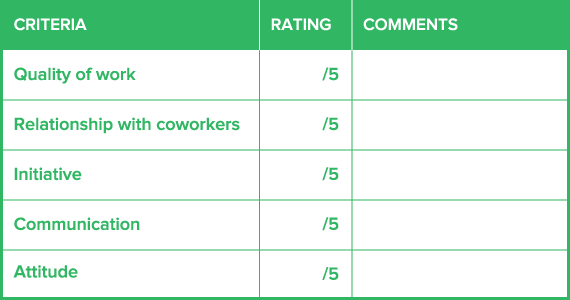The trick is to keep it simple.
What often ends up happening, is companies over complexify these things for no reason.
This is a huge mistake though, because if it’s too long or complex, managers will have issues filling it out, and it might make the process broken.
I’ve written a bit about performance evaluations lately, and one of the things I’ve continued to say was that you need to take a step back, and understand why you’re doing this in the first place.
Let’s explore.
Key Takeaways:
- Keep employee evaluations simple and focused on constructive feedback for improvement.
- Utilize digital platforms for efficiency and environmental considerations.
- Open-ended questions and structured scorecards are both effective, depending on your company’s culture and needs.
- Clear communication and consistency are essential for meaningful evaluations.
- Separate performance evaluations from compensation to emphasize development.
What Employee Evaluation Forms Are Used For By Professionals
What you should be doing, is evaluating an employee’s performance, to get them to improve.
You should not be tying their pay in any way to this evaluation.
This is strictly to evaluate their performance, and then hopefully provide feedback and find ways that they can improve.
There are some companies out there that still do this using paper, which is kind of silly, and bad for the environment, so do all of this virtually.
The other benefit of doing it virtually, is that it’s recorded, and managers and employees can go back and revisit the forms easily.
I’ll lay out a few examples of what I think a good employee evaluation form is, and I’ll try and explain my reasoning for everything to help give some context.
Examples Of Succesful Employee Evaluation Forms
Let’s look at two examples together.
1. Easy Open Ended
To me, this is the way to do it, you keep it super simple, open ended, and you don’t have scores and ratings and other things like that.
Again, taking a step back and understanding what we’re trying to do here, it might be a smarter idea to ask 2 or 3 open ended questions to get the discussion started, and then you just have an open and honest chat about performance and what could be improved.
Imagine it was as simple as this:
1) Name 3 things that employee X did well this year? Please include specific examples.
2) Name 3 things that employee X could improve on next year? Please include specific examples.
Very simple, very straightforward, but somewhat informal.
Personally, I’m okay with that, but I know some companies might not be.
2. Scorecard
The second example we can look at is more formal, and uses a scorecard rating system.
It doesn’t necessarily matter what your ratings are, but ideally, keep them simple and clear.
For example, you can have a rating out of 5, with 1 being the lowest and 5 being the highest.
It’s very important that the rating scale that you use is consistent, and very descriptive. There should be no confusion on any managers part about what each number means.
From there, you could list out a few criteria that you want to rank employees for, like quality of work, knowledge of position, relationship with coworkers, initiative, etc… and then rank each one on the form.
It’s also important that you allow a section for comments on each field of the form.
It makes sense for managers to explain why they’re giving this rating, ideally being able to back it up with specific examples.

5 – This employee always goes above and beyond the normal duty, their work is always high quality, and they have a great relationship with everyone in the office.
4 – Always meets their normally expected tasks, and sometimes goes above and beyond. Shows a lot of initiative, and has a good relationship with others
3 – Does their work as expected, but rarely goes above and beyond. Still learning, and getting used to their position.
2 – Falling below expectations, and rarely meets their expected goals, performance has been declining in recent weeks, and this employee seems disengaged
1 – This is employee is completely disengaged, and is always falling short of their requirements
For this example, again, ideally use software to help, and have the scores automatically calculate as you enter things in, this can help avoid any errors that managers might make when tallying up the score.
These are only a few examples, but remember, take a step back, keep it simple, keep it clean.
What Do You Think About Employee Evaluation Forms?
Effective employee evaluations hinge on simplicity, clarity, and a focus on growth. Choosing the right approach fosters a culture of continuous improvement and development.
Any tips on how to make the perfect employee evaluation form? Let us know in the comments!